Overview
This article outlines seven essential tips for achieving success in aerial lift equipment rentals, underscoring the critical importance of safety, meticulous planning, and effective communication.
- Assess project requirements to ensure the right equipment is selected.
- Evaluate rental terms to understand the obligations and protections involved.
- Ensure operator training is paramount; well-trained operators significantly reduce risks associated with equipment use.
- Confirm logistics, as it enhances operational efficiency and minimizes potential disruptions.
By adhering to these guidelines, businesses can effectively mitigate risks and optimize their equipment utilization.
Key Highlights:
- EZ Equipment Rental is a leading provider of aerial lift rentals in the Dallas-Fort Worth area, offering boom lifts, mini excavators, and forklifts.
- Customer satisfaction is high, with a reported 95% satisfaction rate, emphasising the company's commitment to service excellence.
- Boom lifts provide vertical and horizontal reach for hard-to-access areas, while scissor lifts offer stable vertical elevation for indoor tasks.
- Safety statistics indicate that 25% of aerial equipment fatalities are linked to scissor lift incidents, highlighting the need for proper training and safety measures.
- Before renting, assess project requirements such as height, weight capacity, and reach to ensure safety and efficiency.
- Evaluate rental terms including flexibility, lease duration, and pricing to align with project needs and budget.
- Cheque equipment maintenance records and safety history to ensure compliance with regulations and minimise risks.
- Research the rental company's reputation through customer reviews to ensure quality service and support.
- Confirm delivery and pickup logistics to avoid project delays and ensure timely access to equipment.
- Operator training and certification are crucial for compliance with safety regulations and reducing accident risks.
- Understand insurance requirements to protect your rental investment from potential damages or accidents.
- Maintain open communication with the rental provider to address concerns and ensure a smooth rental experience.
Introduction
Navigating the world of aerial lift equipment rentals can be a daunting task, particularly due to the myriad of options and considerations involved. It is essential to understand the nuances of different lift types, safety protocols, and rental agreements to ensure project success. This article delves into seven crucial tips designed to empower individuals and project managers alike. By making informed decisions, streamlining rental processes, and enhancing both safety and efficiency on the job site, you can transform your rental experience.
What key factors can elevate a standard rental into a seamless and successful operation?
EZ Equipment Rental: Premier Aerial Lift Rental Services in Dallas-Fort Worth
EZ Equipment Rental stands out as the premier choice for aerial platform leases in the Dallas-Fort Worth region. Committed to quality and client satisfaction, they offer an extensive selection of machinery rentals, including:
- Boom lifts
- Mini excavators
- Forklifts
These rentals are tailored to meet the specific needs of both personal and commercial projects. Their expert team ensures that clients acquire the right tools for their tasks, significantly enhancing project efficiency and safety.
With impressive customer satisfaction ratings, such as a 95% satisfaction rate reported by clients in Irving, TX, the company exemplifies a steadfast commitment to service excellence, solidifying their position as the go-to option for tool leasing in the area.
As industry leaders highlight the critical role of quality in equipment rental, with experts asserting, 'Quality equipment is essential for project success,' EZ Equipment Rental consistently sets the benchmark for reliability and performance throughout the DFW Metroplex.
Understand Aerial Lift Types: Boom Lifts, Scissor Lifts, and More
Aerial hoists come in various types, each designed for specific tasks. Boom elevating devices excel in accessing elevated, difficult-to-reach locations, providing both vertical and horizontal reach. Conversely, scissor platforms offer stable vertical elevation, making them suitable for indoor activities and projects requiring a larger surface area. Understanding these distinctions enables customers to select the appropriate aerial lift equipment rental for their specific requirements, thereby enhancing safety and productivity at the job site.
Safety is paramount when choosing between these two types of elevating devices. Statistics reveal that approximately 25% of aerial equipment fatalities are linked to scissor equipment incidents, often due to falls or tip-overs. Annually, an average of 20-25 fatalities occur while using various mobile elevating work platforms (MEWPs), including scissor devices. This underscores the importance of understanding the operational limits and precautionary measures associated with each type of hoist.
Recent advancements in aerial elevation technology have significantly improved safety features, such as enhanced stability systems and sophisticated operator controls, which can greatly reduce the likelihood of accidents. Experts advocate that construction managers prioritize comprehensive training for operators, as proper knowledge of aerial lift equipment rental and adherence to safety guidelines can lead to a remarkable 47% reduction in accidents.
The practical applications of aerial lift equipment rental vary across sectors. For example, boom platforms are frequently utilized in construction and maintenance tasks that require access to high elevations, while scissor platforms are commonly employed in warehouse settings for inventory management and in construction for interior work. By recognizing the distinct benefits and safety considerations of boom and scissor platforms, project managers can make informed decisions that enhance both safety and productivity on the job site.
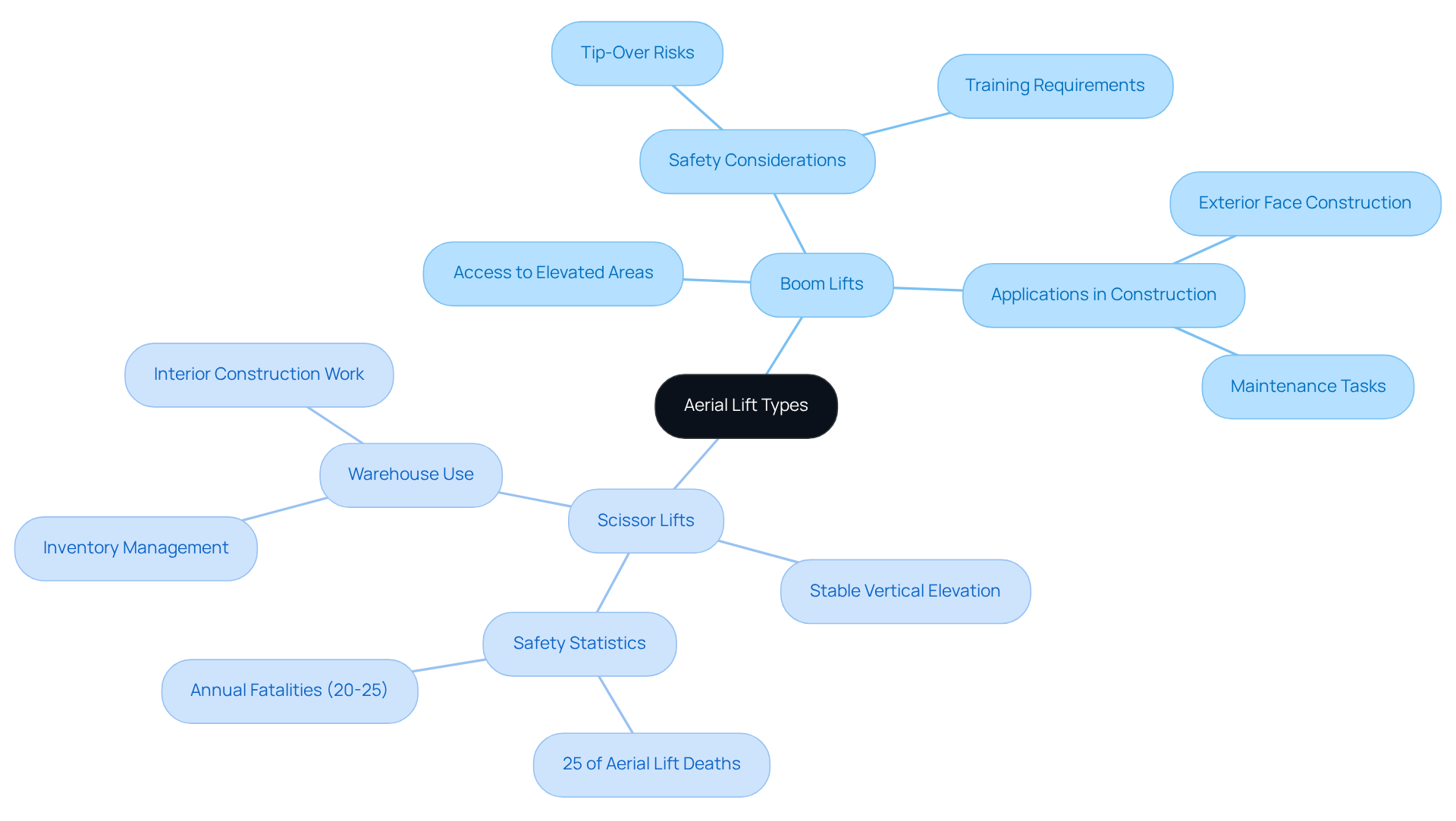
Assess Project Requirements: Determine Height, Weight Capacity, and Reach
Before renting aerial lift equipment rental, it is paramount to evaluate your project needs. Begin by determining the maximum height you need to reach, the weight capacity required for personnel and materials, and the necessary reach for your specific tasks. The weight capacity for aerial devices varies significantly across industries, with many models supporting between 500 to 2,250 pounds. It is crucial to ensure that the elevator's specifications exceed the combined weight of personnel and equipment, thereby reducing risks. In 2025, guidelines emphasize that elevators should be selected based on the specific height and weight requirements of the project, taking into account factors such as terrain and the type of work involved.
Project managers often highlight the importance of these assessments, noting that a thorough evaluation can prevent costly delays and enhance conditions on site. For instance, if a project requires reaching a height of 50 feet, it is advisable to choose a platform with a capacity of at least 1,000 pounds to comfortably accommodate both workers and equipment. Furthermore, it is essential to consider the integrated protective features of aerial platforms, such as guardrails and harness attachment points, which significantly reduce the risk of falls. Proper training and certification for aerial equipment operators are vital for minimizing accidents and ensuring safety on construction sites.
Additionally, maintaining a safe distance from overhead power lines is critical to prevent electrocution. By prioritizing these considerations, you can ensure that the aerial lift equipment rental you choose will effectively meet your project demands. This approach ultimately leads to enhanced operational efficiency and minimized risks, making your project a success.
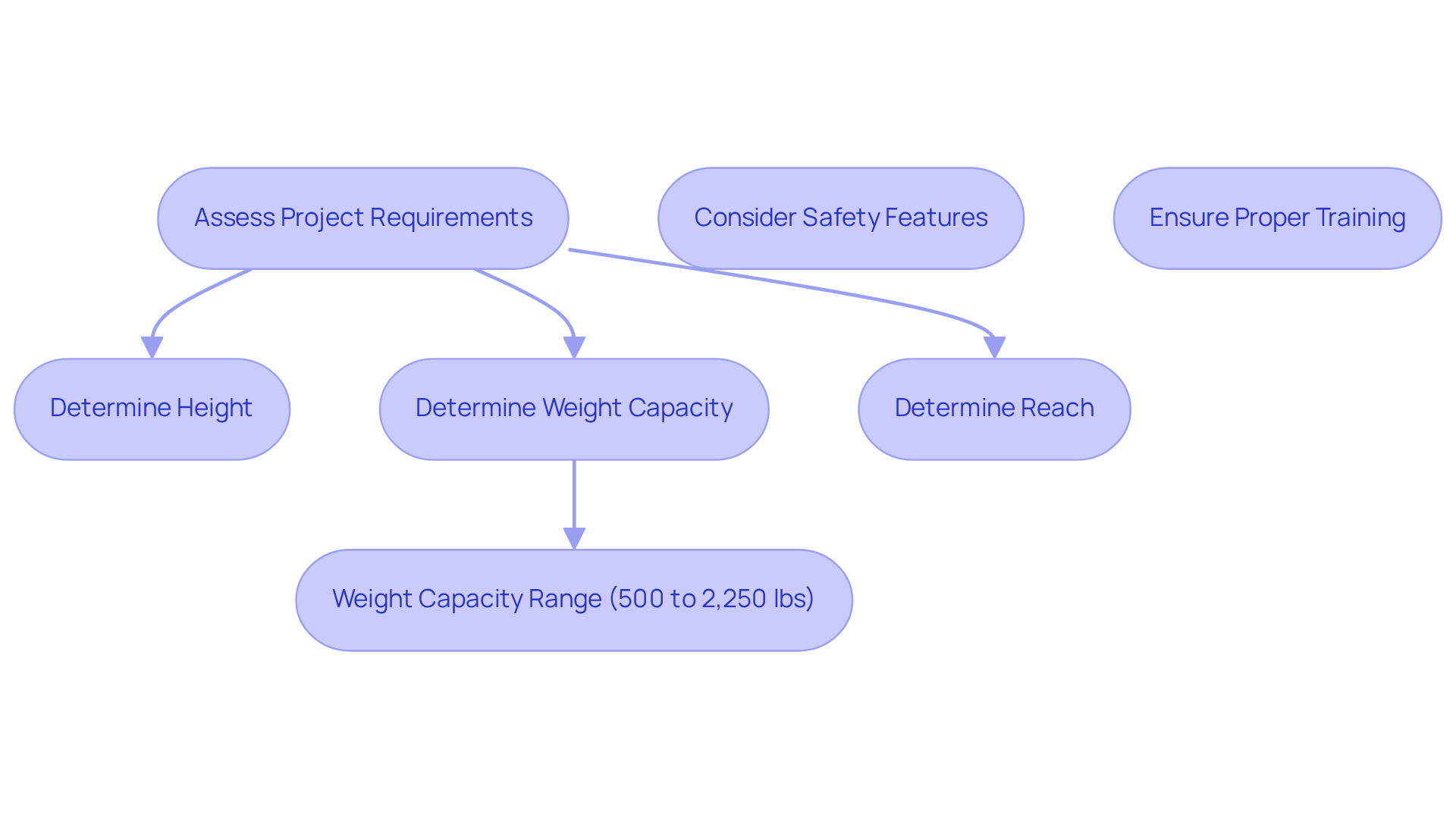
Evaluate Rental Terms: Flexibility, Duration, and Pricing Structures
When evaluating the lease conditions for aerial lift equipment rental, it is essential to prioritize the following factors:
- The flexibility of the agreement
- The duration of the lease
- The available pricing structures
Numerous leasing businesses offer options that allow for extensions or modifications based on project needs, which is crucial for adapting to evolving demands. In fact, a survey revealed that 62% of respondents cited flexibility in returning rented equipment as their primary reason for choosing rentals. This flexibility can significantly aid in managing your budget and avoiding unexpected costs.
Cost-effective options are equally important. For example:
- A 34-foot diesel articulating boom apparatus can be rented for approximately $260 per day
- A 60-foot telescopic boom device costs around $355 per day
- An electric boom lift of similar size costs about $242 per day
Understanding these pricing structures empowers you to make informed decisions that align with your financial goals. Financial specialists emphasize the significance of effective budgeting, recommending that allocating a portion of your housing budget for unexpected costs can help avert financial pressure. The typical usage period for construction tools is usually about two weeks, which is vital to keep in mind when organizing your project.
By carefully evaluating these factors, you can ensure a successful aerial lift equipment rental that meets your project demands without exceeding your budget. Take control of your equipment rental needs today and make choices that will lead to a seamless and cost-effective project execution.
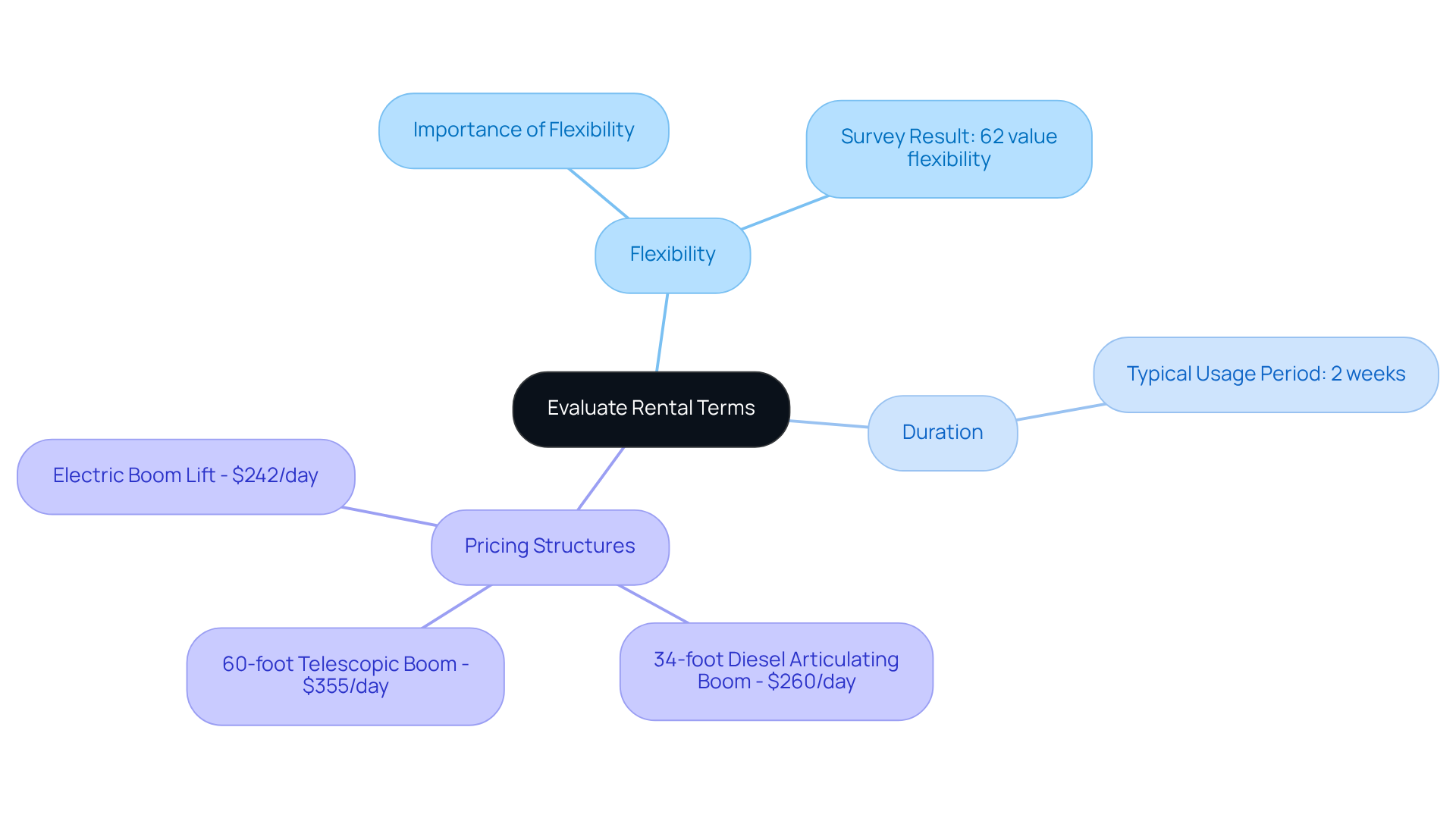
Check Equipment Maintenance: Safety Records and Inspection History
Before leasing an aerial lift equipment rental, it is essential to examine the equipment's maintenance documentation and risk history. Aerial lift equipment rental requires evaluations every 150 hours or every three months, whichever occurs first. These evaluations must be conducted by certified mechanics to ensure adherence to regulatory standards. This diligence not only enhances security but also guarantees optimal performance throughout the aerial lift equipment rental period, significantly reducing the risk of operational issues. For example, a structured inspection program can help identify potential hazards before they lead to accidents, as evidenced by case studies that highlight the consequences of neglecting inspections.
In 2025, following inspection standards is more crucial than ever, with inspectors emphasizing that thorough documentation of inspection history is vital for compliance with OSHA and ANSI regulations. Alarmingly, an average of 26 construction workers die each year due to aerial platform falls, underscoring the dangers associated with overlooking inspections. By ensuring that your aerial lift equipment rental has a solid safety record and adhering to a structured maintenance program, you can mitigate risks, enhance the overall safety of your worksite, and improve cost control.

Research Rental Company Reputation: Customer Reviews and Support Services
Thoroughly researching a rental company's reputation is essential for ensuring a successful aerial lift equipment rental experience. Begin by analyzing customer reviews and testimonials, focusing on feedback regarding product quality, customer service, and support services. EZ Equipment Rental stands out in Dallas due to its unwavering commitment to excellence, consistently receiving positive reviews that reflect a robust track record of satisfied customers.
For example, numerous clients have lauded the reliability of our equipment and the responsiveness of our support team. According to industry analysts, 94% of American customers are likely to recommend a company whose service they rate as 'very good.' This statistic underscores the significant impact that customer service has on a leasing company's reputation.
Moreover, 89% of consumers are more inclined to make another purchase after a positive customer service experience, further highlighting the importance of fostering long-term relationships with clients. Successful leasing companies, such as EZ Equipment Rental, frequently emphasize positive customer feedback as a cornerstone of their aerial lift equipment rental business strategy.
This approach is supported by case studies that demonstrate that investing in customer service leads to enhanced customer retention and improved revenue growth. Furthermore, 72% of customers will share their satisfying experiences with six or more people, illustrating the ripple effect of positive customer interactions.
By prioritizing businesses with exceptional customer support and a strong reputation, like EZ Equipment Rental, you can ensure a smoother process and a more gratifying overall experience.
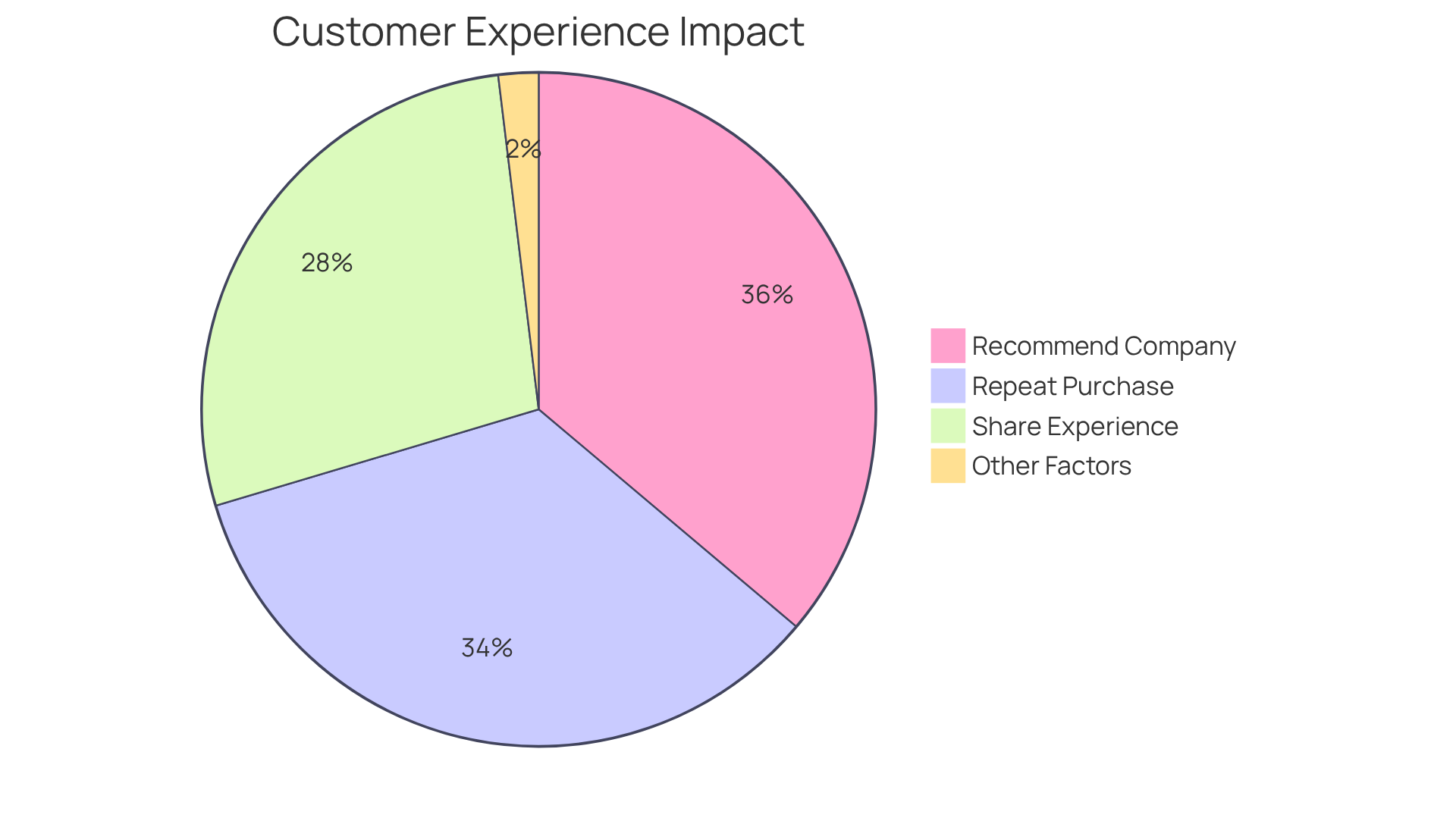
Confirm Delivery and Pickup Options: Logistics for Your Project
Before concluding your lease, it is essential to verify the delivery and pickup options offered by the leasing company. Ensure they can provide the materials to your job site on the specified date and time. Additionally, inquire about the pickup process once your project is complete. Efficient logistics are crucial for keeping your project on schedule and minimizing downtime; delays can significantly impact overall productivity. In fact, 30% of equipment leasing companies have reported challenges related to logistics, including supply chain disruptions and labor shortages, which can hinder timely delivery. Rising inflation and supply restraints further complicate these logistics challenges.
Project managers emphasize that streamlined logistics not only enhance operational efficiency but also contribute to project success. As logistics consultant Stephen Banda notes, 'The phrase 'time is money' has never been more relevant to logistics than it is now.' For example, companies such as United Rentals have established efficient delivery and pickup procedures for aerial lift equipment rental. They frequently encounter smoother operations and fewer delays, ultimately resulting in improved project outcomes. By prioritizing logistics, you position your project for success and ensure that your equipment needs are met promptly.
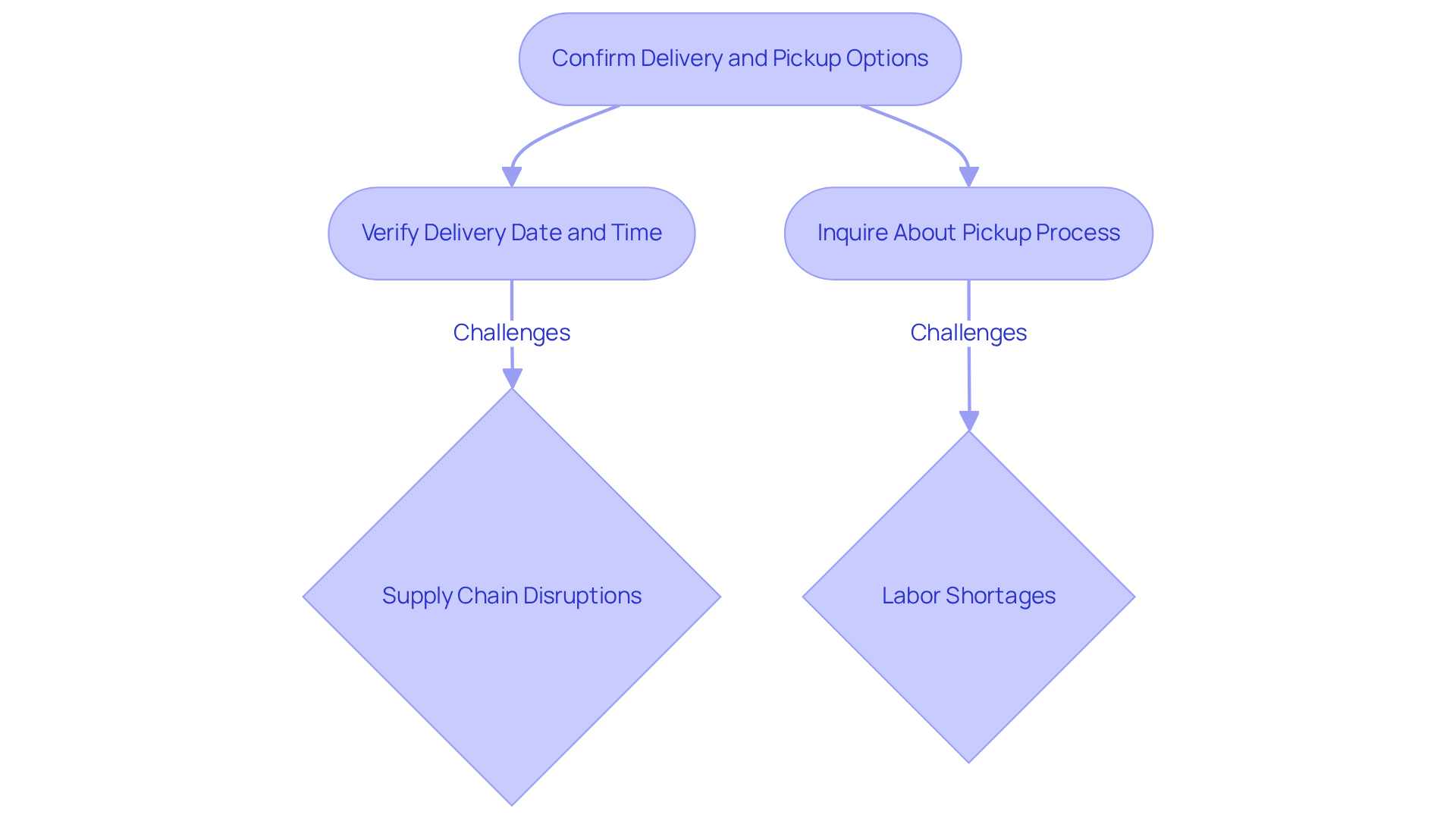
Ensure Operator Training: Compliance with Safety Regulations
Before operating an aerial lift, it is crucial that all operators complete comprehensive training and certification related to aerial lift equipment rental. Compliance with safety regulations is not merely a legal obligation; it is vital for preventing accidents and ensuring the overall safety of operations. Training programs must encompass:
- Equipment handling
- Precautionary protocols
- Emergency procedures
This equips operators to effectively navigate various scenarios. Alarmingly, statistics reveal that an average of 26 construction workers lose their lives each year due to falls from aerial equipment, with aerial devices accounting for 2 to 3% of all construction fatalities. This underscores the urgent necessity for thorough training.
Furthermore, breaches of safety rules are the leading cause of boom machinery incidents, often stemming from a failure to adhere to established protocols. Experts in the field assert, "Most aerial hoist incidents and aerial hoist fatalities can be prevented by keeping buckets free from overhead objects, such as power lines, and by utilizing appropriate harnesses and protective equipment."
By ensuring operators are well-trained and compliant with regulations, companies can significantly mitigate the risks associated with the use of aerial lift equipment rental operations. As highlighted in the case study 'Causes of Boom Lift Accidents,' neglecting precautionary measures can lead to serious injuries or fatalities. Rigorous operator training not only bolsters safety but also cultivates a culture of accountability and diligence within the workplace.
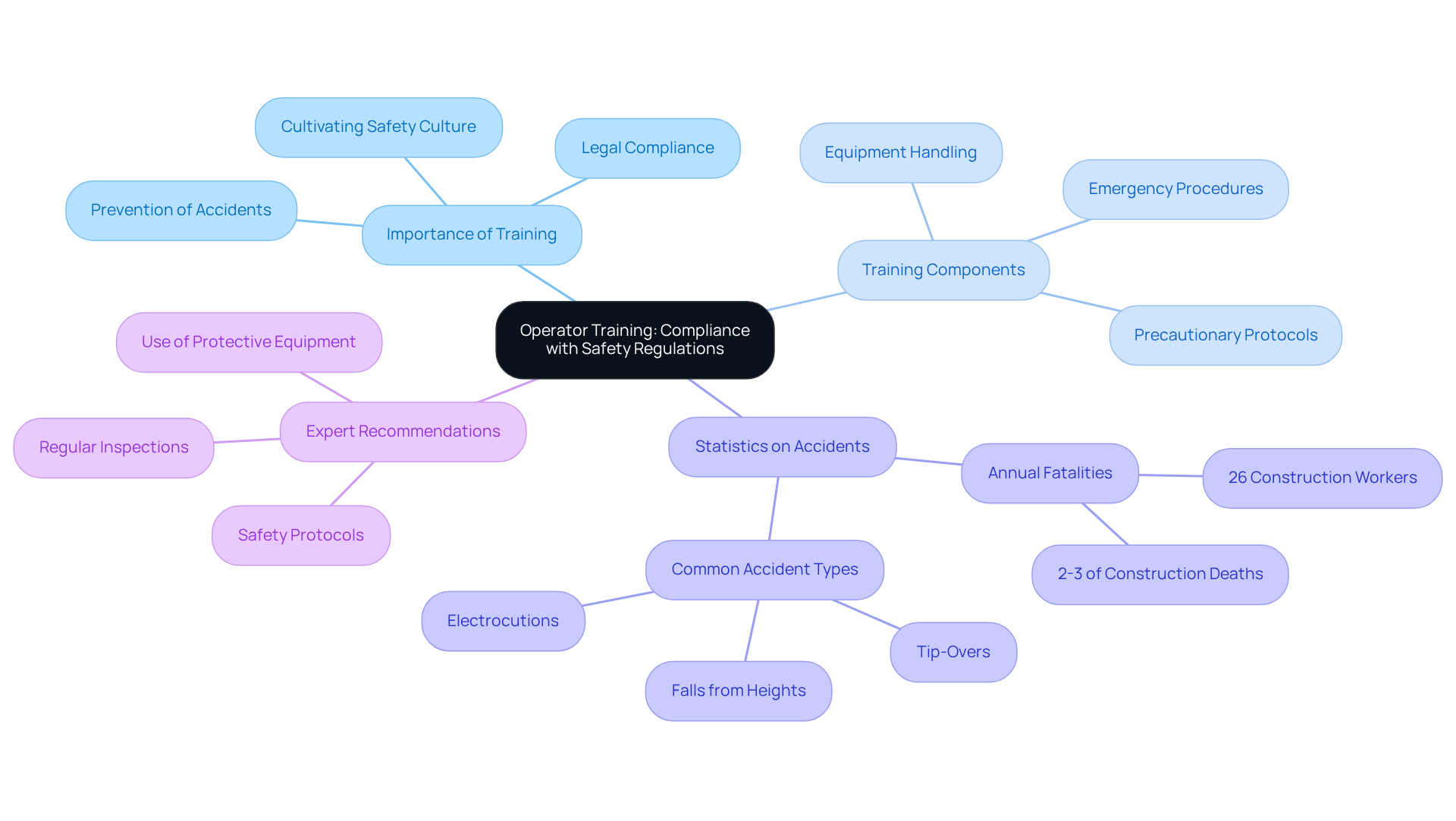
Understand Insurance Requirements: Protecting Your Rental Investment
Before leasing aerial lift equipment rental, it is crucial to understand the insurance stipulations set by the leasing company. Many companies require proof of insurance or offer their own coverage options, significantly impacting your financial liability in the event of damages or accidents. For instance, damage waivers often limit your financial responsibility to a specified amount, typically capped at a certain dollar value, while comprehensive insurance for leased equipment can cover a broader range of incidents, including theft, vandalism, and natural disasters.
Statistics reveal that approximately 70% of leasing firms provide optional insurance coverage as part of their agreements, presenting a cost-effective way to safeguard your investment. Engaging with insurance professionals can provide valuable insights into the types of coverage available, such as General Liability Insurance, which protects against third-party bodily injury and property damage resulting from the aerial lift equipment rental.
To effectively protect your leasing investment, ensure that your insurance policy aligns with the equipment's value and includes coverage for potential risks. Additionally, obtaining a Certificate of Insurance (COI) is essential for demonstrating your insurance coverage to the leasing company. This proactive strategy not only reduces unexpected costs but also enhances your overall project management approach, enabling you to concentrate on the successful execution of your construction projects.
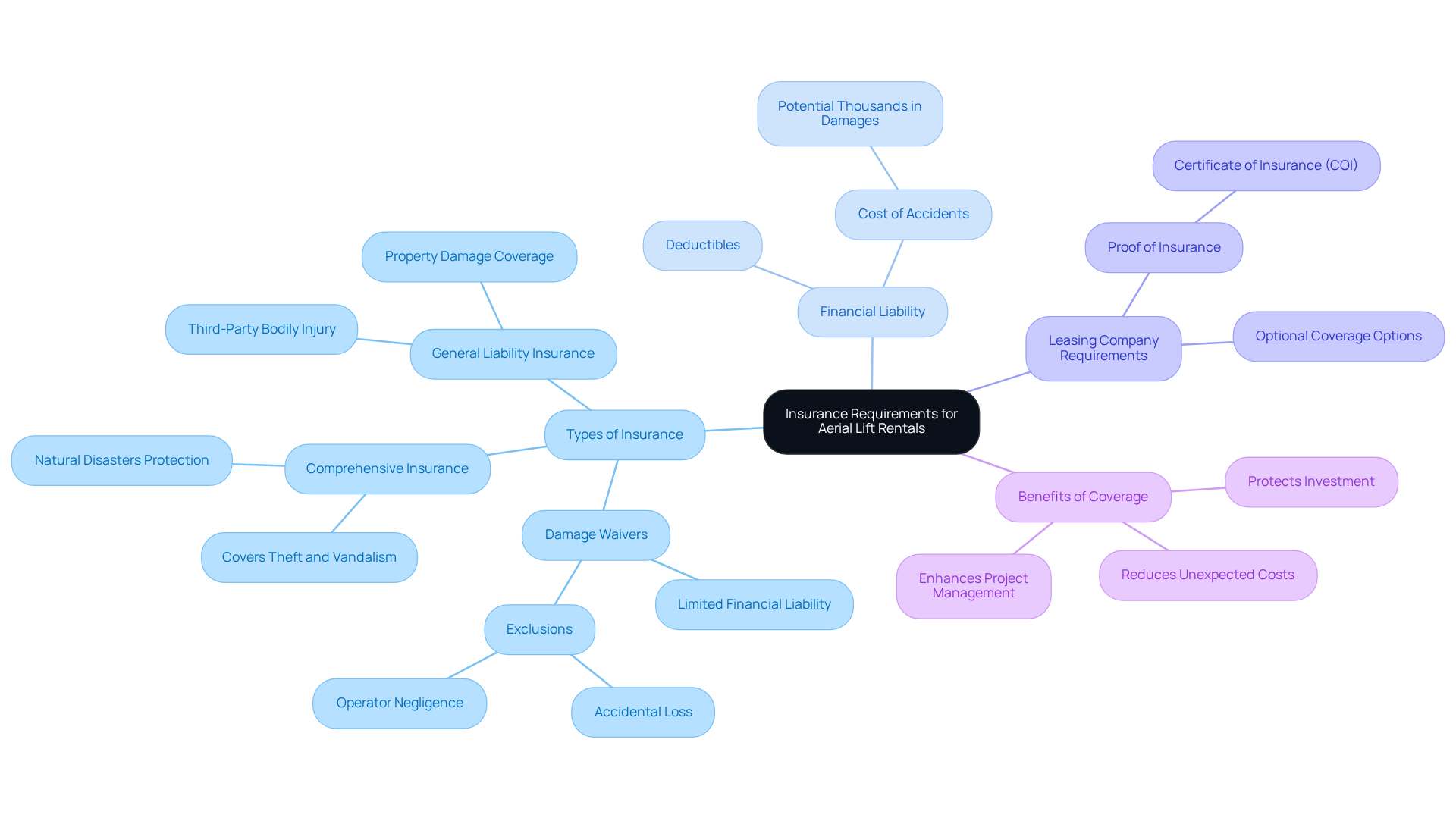
Communicate Clearly with Rental Provider: Addressing Concerns and Questions
Establishing open lines of communication with your leasing provider is essential throughout the leasing process. Address any concerns or questions regarding the equipment, leasing terms, or logistics promptly. A responsive leasing company is not only willing to assist but is also dedicated to providing the necessary information to ensure a seamless leasing experience.
With store hours from Monday to Friday, 7:30 AM to 5:30 PM, and Saturday from 7:30 AM to 5:00 PM, EZ Equipment Rental has a knowledgeable team ready to assist you. By fostering a dialogue with your rental provider, you can mitigate potential issues and enhance your overall satisfaction with the rental process.
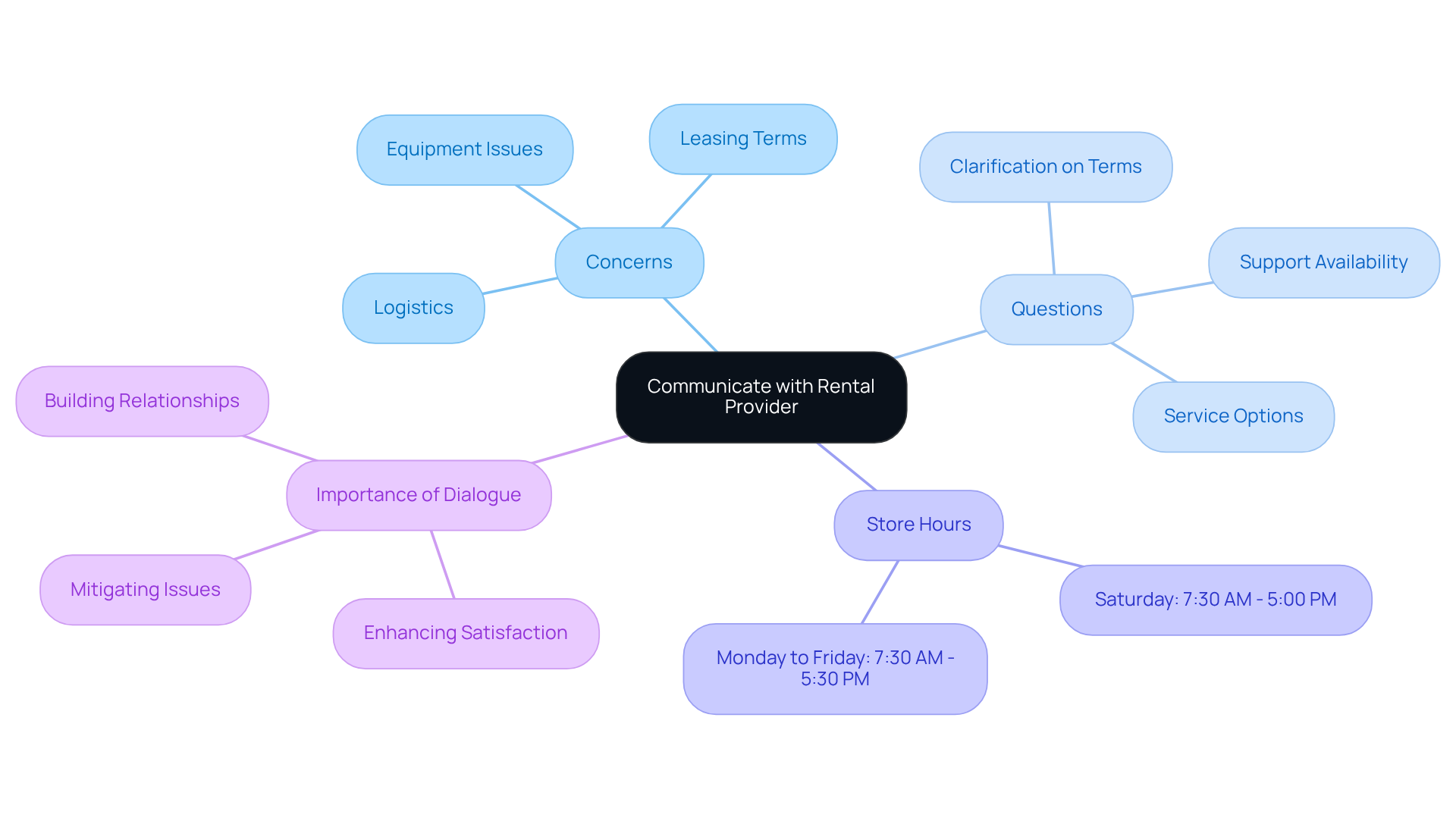
Conclusion
Selecting the right aerial lift equipment rental is pivotal for ensuring project success and safety. Understanding the various types of lifts available, accurately assessing project requirements, and focusing on safety and compliance significantly enhance operational efficiency. The insights provided throughout this article emphasize the importance of thorough preparation and informed decision-making in the equipment rental process.
Key points such as evaluating rental terms, checking equipment maintenance records, and confirming logistics highlight the multifaceted approach needed for effective aerial lift rentals. Furthermore, the emphasis on operator training and insurance requirements reinforces the necessity of prioritizing safety and financial protection throughout the rental period.
Ultimately, the success of aerial lift equipment rental hinges on careful planning and proactive communication with rental providers. By implementing these essential tips, project managers can ensure that their equipment needs are met efficiently, paving the way for productive and safe work environments. Taking these steps not only safeguards investments but also contributes to the overall success of construction projects, making informed choices in aerial lift rentals a crucial aspect of project management.
Frequently Asked Questions
What types of aerial lift equipment does EZ Equipment Rental offer?
EZ Equipment Rental offers a variety of aerial lift equipment, including boom lifts, mini excavators, and forklifts.
How does EZ Equipment Rental ensure customer satisfaction?
EZ Equipment Rental has a 95% customer satisfaction rate reported by clients in Irving, TX, and their expert team helps clients select the right tools for their specific project needs.
What is the difference between boom lifts and scissor lifts?
Boom lifts excel in accessing elevated, hard-to-reach locations with both vertical and horizontal reach, while scissor lifts provide stable vertical elevation, making them suitable for indoor tasks requiring a larger surface area.
What safety concerns are associated with aerial lift equipment?
Approximately 25% of aerial equipment fatalities are linked to scissor lift incidents, often due to falls or tip-overs. Annually, 20-25 fatalities occur with various mobile elevating work platforms (MEWPs), highlighting the need for understanding operational limits and safety precautions.
How can proper training impact the safety of aerial lift operations?
Comprehensive training for operators can lead to a remarkable 47% reduction in accidents, emphasizing the importance of knowledge regarding aerial lift equipment and adherence to safety guidelines.
What should be considered when assessing project requirements for aerial lift rentals?
It is crucial to evaluate the maximum height needed, weight capacity for personnel and materials, and the necessary reach for specific tasks. The equipment's specifications should exceed the combined weight of personnel and equipment to reduce risks.
What are some protective features to look for in aerial lift equipment?
Integrated protective features such as guardrails and harness attachment points are important to reduce the risk of falls.
Why is it important to maintain a safe distance from overhead power lines when using aerial lifts?
Maintaining a safe distance from overhead power lines is critical to prevent electrocution during aerial lift operations.




